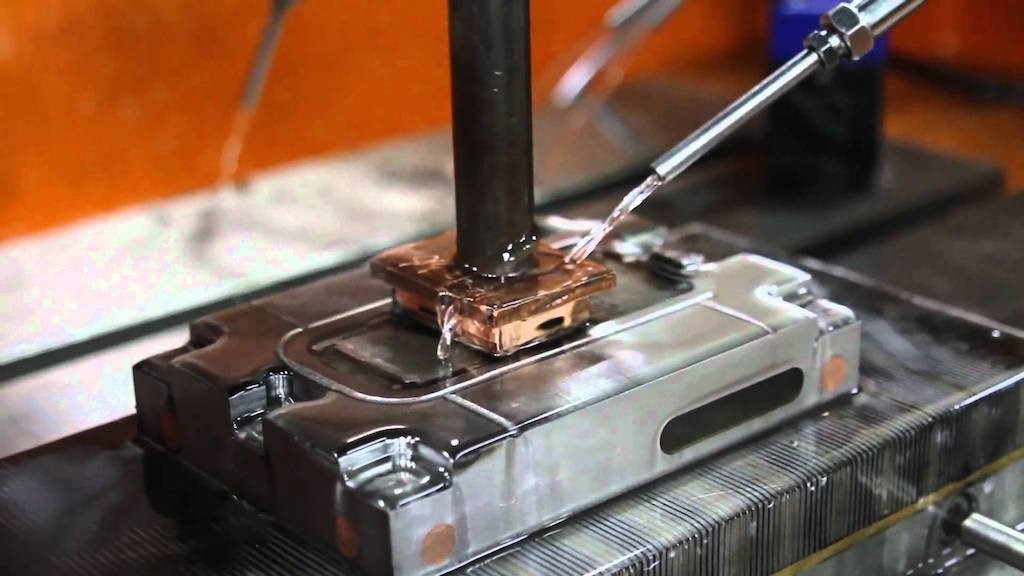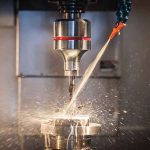EDM involves the direction of high-frequency electrical spark discharges from a graphite or soft metal tool, which serves as an electrode, to disintegrate electrically conductive materials such as hardened steel or carbide. The electrode and workpiece are immersed in a dielectric liquid, and a feed mechanism maintains a spark gap of from 0.0005 to 0.020 inch (0.013 to 0.5 millimetre) between the electrode and the workpiece. As spark discharges melt or vaporize small particles of the workpiece, the particles are flushed away, and the electrode advances. The process is accurate, but slow, and is used for machining dies, molds, holes, slots, and cavities of almost any desired shape. In CNC wire machining, a thin copper wire is used as the tool for cutting out two- and three-dimensional fretwork profiles.
Electrochemical machining (ECM)
ECM resembles electroplating in reverse. In this process metal is dissolved from a workpiece with direct current at a controlled rate in an electrolytic cell. The workpiece serves as the anode and is separated by a gap of 0.001 to 0.030 inch (0.025 to 0.75 millimetre) from the tool, which serves as the cathode. The electrolyte, usually an aqueous salt solution, is pumped under pressure through the inter-electrode gap, thus flushing away metal dissolved from the workpiece. As one electrode moves toward the other to maintain a constant gap, the anode workpiece is machined into a complementary shape. The advantages of ECM are lack of tool wear and the fact that a softer cathode tool can be used to machine a harder workpiece. Applications of ECM can be found in the aircraft engine and automobile industries, where the process is used for deburring, drilling small holes, and machining extremely hard turbine blades.
Other versions of ECM include electrolytic grinding, which includes about 90 percent ECM with 10 percent mechanical action; electrochemical arc machining (ECAM), in which controlled arcs in an aqueous electrolyte remove material at a fast rate; and capillary drilling, in which acid electrolytes are used to machine very fine holes.
Ion beam machining (IBM)
In IBM a stream of charged atoms (ions) of an inert gas, such as argon, is accelerated in a vacuum by high energies and directed toward a solid workpiece. The beam removes atoms from the workpiece by transferring energy and momentum to atoms on the surface of the object. When an atom strikes a cluster of atoms on the workpiece, it dislodges between 0.1 and 10 atoms from the workpiece material. IBM permits the accurate machining of virtually any material and is used in the semiconductor industry and in the manufacture of aspheric lenses. The technique is also used for texturing surfaces to enhance bonding, for producing atomically clean surfaces on devices such as laser mirrors, and for modifying the thickness of thin films and membranes.
Laser machining (LM)
LM is a method of cutting metal or refractory materials by melting and vaporizing the material with an intense beam of light from a laser. Drilling by laser, although costly in energy since material must be melted and vaporized to be removed, is used to cut small holes (0.005 to 0.05 inch [0.13 to 1.3 millimetres]) in materials that are too difficult to machine by traditional methods. A common application is the laser drilling of diamonds to be used as dies for drawing wire. Lasers also are used to drill and cut ceramics and substrates for integrated circuits; the aircraft industry uses CNC-controlled lasers to cut profiles and to drill holes in engine parts.
Plasma arc machining (PAM)
PAM is a method of cutting metal with a plasma-arc, or tungsten inert-gas-arc, torch. The torch produces a high-velocity jet of high-temperature ionized gas (plasma) that cuts by melting and displacing material from the workpiece. Temperatures obtainable in the plasma zone range from 20,000° to 50,000° F (11,000° to 28,000° C). The process may be used for cutting most metals, including those that cannot be cut efficiently with an oxyacetylene torch. With heavy-duty torches, aluminum alloys up to six inches (15 centimetres) thick and stainless steel up to four inches (10 centimetres) thick have been cut by the PAM process. The process is used for the profile cutting of flat plate, for cutting grooves in stainless steel, and, on lathes, for turning large, hardened steel rolls.


